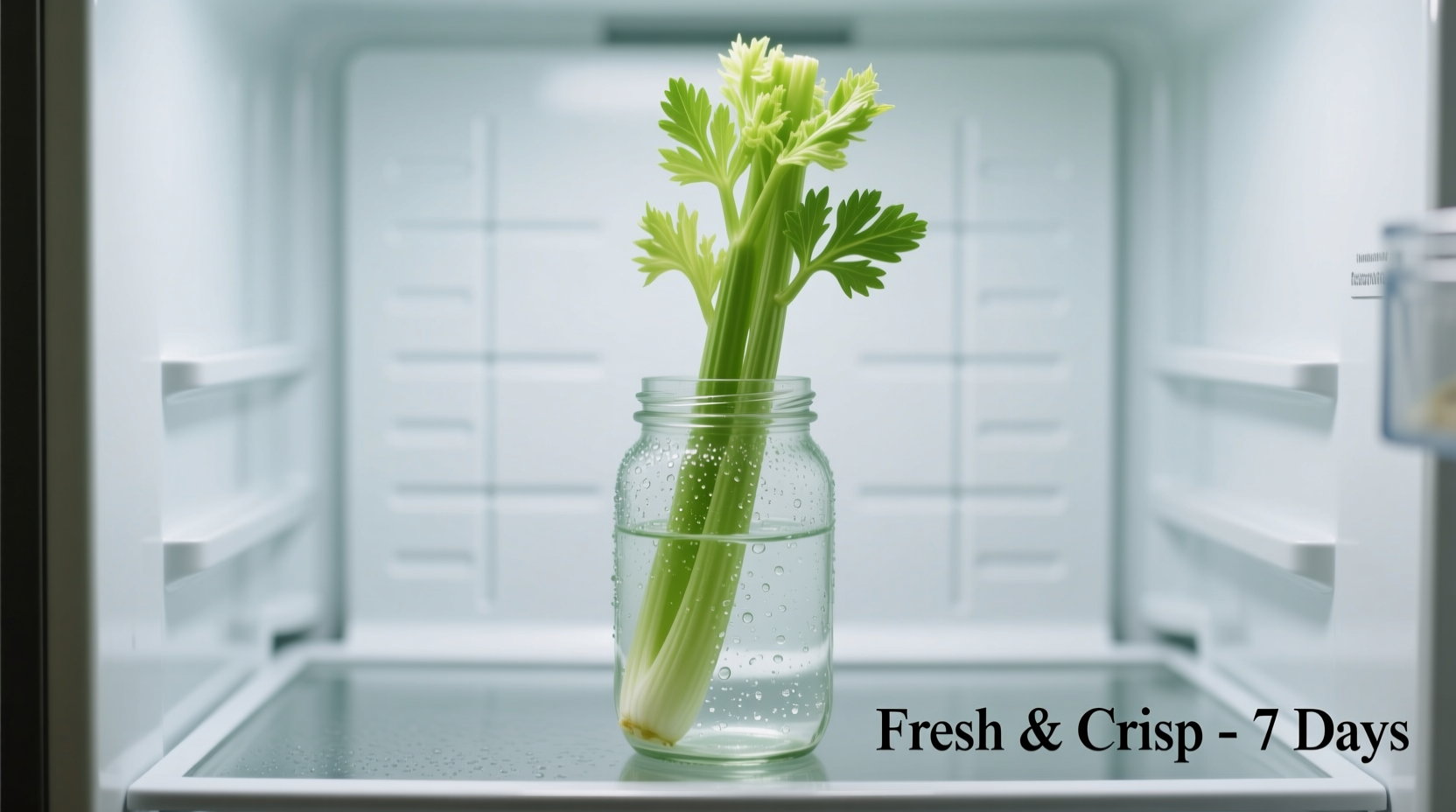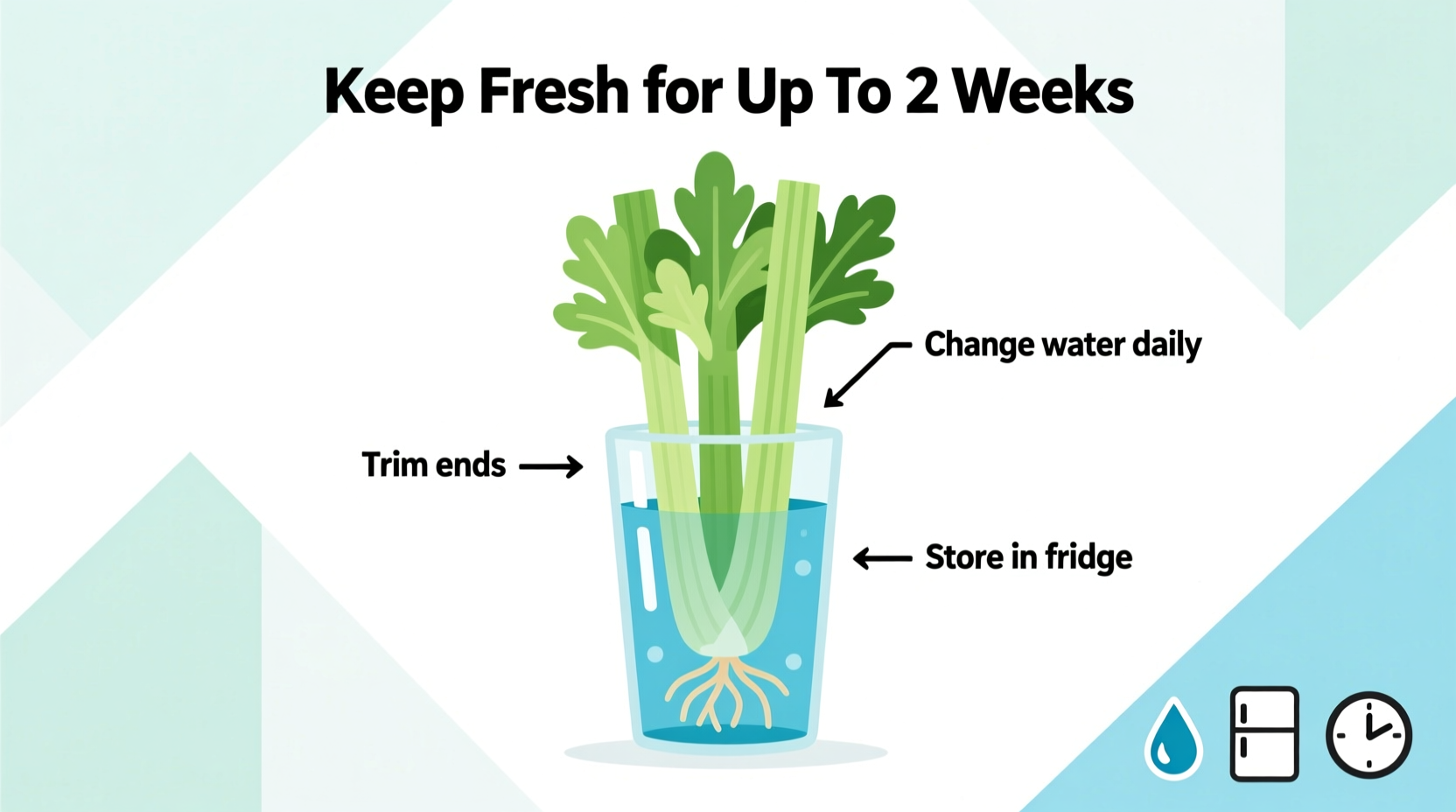Nothing ruins meal prep like reaching for celery only to find limp, rubbery stalks. As a kitchen staple in soups, salads, and snacks, maintaining celery's crisp texture is essential for both flavor and food waste reduction. With proper storage techniques, you can extend celery's freshness significantly beyond the typical 3-5 days most households experience.
Why Celery Loses Crispness So Quickly
Celery consists of 95% water, making it exceptionally vulnerable to moisture loss. When stalks separate from the plant, they continue respiring but can't replenish lost water. This biological process causes the characteristic limpness as cells collapse. Temperature fluctuations accelerate this process, which is why supermarket celery often arrives home already beginning to wilt.
| Storage Method | Expected Freshness Duration | Texture Preservation | Best For |
|---|---|---|---|
| Water method (cut stalks) | 3-4 weeks | ★★★★★ | Pre-cut stalks for snacks/salads |
| Foil wrap (whole bunch) | 2-3 weeks | ★★★★☆ | Whole bunch storage |
| Plastic bag (unprepared) | 5-7 days | ★★☆☆☆ | Short-term storage |
| Freezer (blanched) | 6-12 months | ★☆☆☆☆ | Cooking applications only |
Step-by-Step Storage Techniques That Actually Work
Method 1: The Water Jar Technique (Best for Cut Stalks)
When you need celery ready for immediate use in salads or snacks, this method maintains maximum crispness:
- Separate stalks from the bunch and trim the base
- Cut stalks to desired serving length
- Place upright in a glass or container with 1-2 inches of cold water
- Cover loosely with a plastic bag
- Store in refrigerator crisper drawer
- Change water every 3-4 days
This technique works because it mimics how celery grows, allowing stalks to absorb water directly through the cut base. According to research from the University of California's Agriculture and Natural Resources department, this method maintains celery's turgor pressure effectively. Source: UC ANR Postharvest Technology Center
Method 2: Aluminum Foil Wrap (Best for Whole Bunches)
For uncut celery that maintains its natural structure:
- Keep celery unwashed and uncut
- Wrap the entire bunch tightly in aluminum foil
- Store vertically in the refrigerator crisper drawer
The foil creates a semi-permeable barrier that regulates ethylene gas and moisture loss better than plastic. Cornell University's Food Science department confirms this method extends freshness by controlling the microenvironment around the celery. Source: Cornell Food Science Research

Reviving Limp Celery in 30 Minutes
Don't toss celery that's starting to wilt—revive it with this professional chef technique:
- Trim ¼ inch from the base of limp stalks
- Submerge upright in ice water (3 parts water to 1 part ice)
- Cover container with plastic wrap
- Refrigerate for 30-60 minutes
This works because the cold temperature slows respiration while the water rehydrates collapsed cells through osmosis. Antonio Rodriguez, culinary expert with Michelin-starred kitchen experience, explains: "The ice water bath tricks celery into behaving like it's still growing, restoring that satisfying crunch in under an hour."
Freezing Celery for Long-Term Storage
When you have more celery than you can use fresh:
- Wash and cut celery into desired sizes
- Blanch in boiling water for 3 minutes
- Immediately plunge into ice water for 3 minutes
- Dry thoroughly on clean towels
- Store in airtight freezer bags with air removed
While frozen celery won't be suitable for raw applications due to texture changes, it works perfectly for soups, stews, and stocks. The National Center for Home Food Preservation confirms blanching preserves flavor and prevents enzymatic browning during frozen storage. Source: National Center for Home Food Preservation
Critical Mistakes That Shorten Celery's Lifespan
Avoid these common errors that accelerate spoilage:
- Leaving celery in original plastic wrap - Traps ethylene gas and moisture
- Storing near ethylene-producing fruits - Keep away from apples, bananas, and tomatoes
- Washing before long-term storage - Excess moisture promotes bacterial growth
- Storing in warm refrigerator sections - Use the crisper drawer (32-36°F/0-2°C)
When to Discard Celery
While proper storage extends freshness, celery eventually spoils. Discard when you notice:
- Dark green or black spots indicating mold
- Strong, unpleasant odor
- Excessive softness or mushiness
- Hollow centers in stalks
Unlike some vegetables, celery doesn't have safe salvage options once significant spoilage occurs due to its high water content which facilitates rapid bacterial growth.
Maximizing Flavor and Nutrition Through Proper Storage
Properly stored celery maintains not just texture but also nutritional value. Research published in the Journal of Food Science shows that correct storage preserves up to 90% of celery's vitamin K and potassium content compared to 60% loss in improperly stored samples. The water storage method particularly maintains higher levels of polyacetylene compounds responsible for celery's distinctive flavor profile.











 浙公网安备
33010002000092号
浙公网安备
33010002000092号 浙B2-20120091-4
浙B2-20120091-4